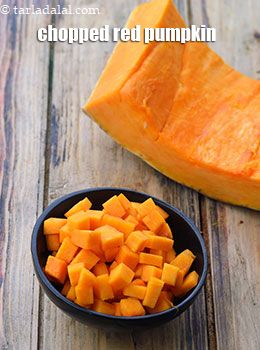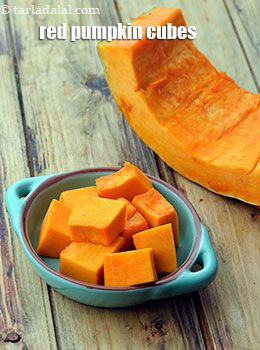![]() Kaddu, Lal Bhopla
Kaddu, Lal Bhopla
What is red pumpkin, kaddu, bhopla?
Red pumpkin or Lal bhopla is poor man's source of carotene in India. Other sources (like apples, carrots) normally happen to be rather expensive when not in the peak of season. Red pumpkin, however, is 'in season' throughout the year unlike in the Western countries, where it is typically an autumn appearance.
We are just beginning to discover the wealth of nourishment supplied by the mildly sweet flavored and finely textured red pumpkin. Red pumpkin is the member of the Cucurbitaceae family come in many different varieties. While each type varies in shape, color, size and flavor, they all have hard protective skins that are difficult to pierce that give them a long storage life.
Chopped and parboiled red pumpkin

Red pumpkin should be washed thoroughly and peeled off. Take a sharp knife, slice it from the top to remove the stem and then cut it into half from the centre then further chop it into small pieces.
Then boil enough water in a deep non-stick pan, place the chopped pumpkin in it and cook it on a medium flame till they are just parboiled which will take approx. 5 to 7 minutes. Use as required.
Chopped red pumpkin

Wash the rind of red pumpkin with water and dry it using a kitchen towel. Use a sharp knife to carefully slice off the top and the bottom. A serrated knife works best for items that have a softer interior and tougher exterior like pumpkin, melons, tomatoes, and breads. Stand the red pumpkin on end, and carefully slice down through the centre. Remove the seeds with the tip of a knife, if you want. Slice red pumpkin into not very thick nor very thin wedges. Remove the rind by inserting a knife between the rind and the flesh to cut it away. Remove all the remaining seeds. Cut the wedges into long uniform strips. Line up the strips with your non-working hand and cut them into square pieces of desired size (approximately ¼ inch in diameter).
Grated red pumpkin

Wash the rind of red pumpkin with water and dry it using a kitchen towel. Use a sharp knife to carefully slice off the top and the bottom. Stand the red pumpkin on end, and carefully slice down through the centre. Remove the seeds with the tip of a knife, if you want. Slice red pumpkin into not very thick nor very thin wedges. Hold the thick/ thin end of the grater in one hand and the red pumpkin wedge in the other hand. Now place the red pumpkin wedge on the blade and push it downwards using the force of your hands to get grated strands of red pumpkin. You can grate it thickly or thinly as per the recipe requirement.
Red pumpkin cubes

Wash the rind of red pumpkin with water and dry it using a kitchen towel. Use a sharp knife to carefully slice off the top and the bottom. Stand the red pumpkin on end, and carefully slice down through the centre. Remove the seeds with the tip of a knife, if you want. Slice red pumpkin into not very thick nor very thin wedges. Remove the rind by inserting a knife between the rind and the flesh to cut it away. Remove all the remaining seeds. Cut the wedges into long uniform thick strips. Line up the strips with your non-working hand and cut them into square pieces of desired size (approximately ½ inch in diameter).
Red pumpkin fingers

Sliced red pumpkin

Holding red pumpkin vertically, slice using a sharp knife by cutting vertically across the cutting board. Slice them thinly or thickly as the recipe requirement.
How to Select red pumpkin, kaddu, bhopla
Choose ones that are firm, heavy for their size and have dull, not glossy, rinds. The rind should be hard as soft rinds may indicate that the squash is watery and lacking in flavor. Avoid those with any signs of decay, which manifest as areas that are water-soaked areas or moldy.
16 Ways to Use red pumpkin, kaddu, bhopla
1. Bhopla in English is known as Red pumpkin. Before using, rinse off any dirt. Cutting the pumpkin may be challenging, use a large knife with a long handle. Once cut in small pieces, you can then remove the seeds, the fibers and the skin.
2. The pumpkin can be boiled or steamed until tender. You can then smash it into a puree or a soup. You can also add cubes of pumpkin to your favorite vegetable soup recipe.
3. You can also cook the whole pumpkin and cut and peel it afterwards. Make some holes in the pumpkin and place it the oven until the skin caramelized. Roasted Pumpkin and Garlic can be prepared in just 10 minutes and complements simple to exotic meals very well.
4. Shredded or diced, the pumpkin can be sautéed in an oiled skillet and served as a side dish.
5. Its flesh is dense and can be shredded. You may want to serve it as a salad along with walnuts, raisins and cheese.
6. The combination of Rocket Leaves, Zucchini Red Pumpkin in balsamic dressing makes a healthy lunch salad.
7. The use of pumpkin is not just limited to subzis and soups. You can also grate them and fortify your doughs and make different flatbreads like Lehsuni Bajra Aur Kaddu ki Roti, Pumpkin Paratha, Kaddu Palak Ki Roti.
8. South Style Mixed Veg Curry is a semi-dry coconut flavored dish with vegetables like red pumpkin, drumsticks, yam, French beans, carrots, raw banana, brinjal making a tasty and tangy dish.
Similarly, you can make a Mangalorean Style Valval that is an assortment of Vegetables in Coconut Milk .
9. You can also make sumptuous snacks like Pumpkin Pakoras, Grilled Pumpkin, Oven Baked Pumpkin Fries.
10. Bhoplyachi Bhaji ( Dangar Chi Bhaji) is an authentic Maharashtrian dish made with spices and an aromatic tempering.
11. Make accompaniments like Red Pumpkin Chutney, Red Pumpkin Pachadi, Pumpkin Raita and lose yourself to the refreshing flavor of them.
12. The usage is not limited to main courses, Gulgule an authentic Maharashtrian sweet is made by deep-frying a batter of sweetened pumpkin flavored with cardamom.
13. It is also used in continental cuisine to make an array of dishes ranging from salads to sandwiches. Penne in Pumpkin Sauce, Creamy Pumpkin Risotto are some delightful Italian preparations with mellow flavor.
14. Thai cuisine also makes use of pumpkin to make a heartwarming Thai Style Pumpkin Soup.
15. Pumpkin is widely used in South Indian cuisine to make various dals like Sambar, Kolumbu.
16. Avial, Pongal Kootu, Pumpkin Kootu Curry are other popular curry from various regions of Southern India.
How to Store red pumpkin, kaddu, bhopla
Winter squash has a much longer storage life than summer squash. Depending upon the variety, it can be kept for one week to six months. It should be kept away from direct exposure to light and should not be subject to extreme heat or extreme cold. The ideal temperature for storing winter squash is between 50-60°F (about 10-15°C). Once it is cut, cover the pieces of winter squash in plastic wrap and store them in the refrigerator, where they will keep for one or two days. The best way to freeze winter squash is to first cut it into pieces of suitable size for individual recipes.
Is Pumpkin (bhopla, lauki) healthy?
Pumpkin is a type of winter squash most commonly termed as bhopla by the vegetable vendors in the Indian market. While in western countries it’s typical an autumn experience, in India it’s available throughout the year. This nutrient rich flesh vegetable can improve your skin, cell health, immunity, eyesight, weight and so on…. It has a very interesting nutrient profile. Let’s study it in detail.
Red pumpkin, kaddu, bhopla offers 7 major health benefits
Yes, Pumpkin is one of the Super foods one must add to their diet
1. Can Pumpkin Aid in Weight Loss?
Pumpkin is an ingredient which has a super decent major nutrient profile. Despite being high in nutrients, it is low in calories (31 calories per cup), carbs (5.7 g per cup) and fat (1.75 g per cup) and should not be missed out by anyone who aims to maintain or lose weight. Though it’s not a wholesome source of fiber, you can take advantage of the other nutrients in this profile. Enjoy this mildly sweet vegetable sliced, roasted, grilled or in the forma a subzi. Want to try something new and exotic with Pumpkin? We have a healthy breakfast option for you – Pumpkin Steel Cut Oats
For complete health benefits Pumpkin (bhopla, lauki) read this article.
Nutritional Value of Pumpkin (kaddu, lal bhopla)
1 cup of pumpkin cubes is about 125 g
RDA stands for Recommended Daily Allowance.
Energy - 31 calories
Protein – 1.75 g
Carbohydrate – 5.75 g
Fat – 0.1 g
Fiber – 0.8 g
Vitamins:
2.5 mg of Vitamin C = 6.25 % of RDA (about 40 mg)
5526 mcg of Vitamin A = 115.1 % of RDA (about 4800 mcg)
16.25 mcg of Folate (vitamin B9) = 16.25% of RDA (about 100 mcg)
Minerals:
47.5 mg of Magnesium = 13.57% of RDA (about 350 mg)
37.5 mg of Phosphorus = 6.25% of RDA (about 600 mg)
241.2 mg of Potassium = 5.13% of RDA (about 4700 g)
7 mg of sodium
Glycemic Index of Red Pumpkin
Red Pumpkin has a Glycemic Index of 75 which is High.
Foods you eat rank from 0 to 50 are low GI, 51 to 69 are medium and 70 to 100 are high.
Foods that are high in GI are not suitable for weight loss and diabetics.
However, the low carb content in pumpkin reduces its effect on blood sugar resulting in a lower GLYCEMIC load of 3 thus making it a super food to have.
So you can safely have pumpkin but do so in moderation.